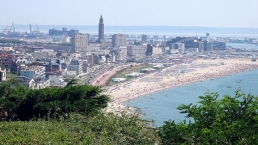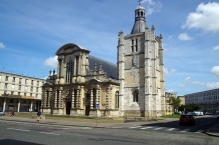Le Havre
Worth visiting
Added on 16 Aug 2014,
last edited by biroto-Redaktion on 23 Mar 2019
Nearby cycle routes and tours
| Route name | Type | Dist. to route |
|---|---|---|
Route | 0,3 km | |
Route | 0,4 km | |
Route | 3,6 km | |
Route | 3,9 km | |
Tour | 0,3 km | |
Tour | 0,4 km | |
Tour | 0,4 km | |
Tour | 0,4 km | |
Tour | 0,4 km |
![]()
Please wait - map data are loading
Type of sights
World heritage site
Name and address
Le Havre
FR-7660 Le Havre
GEO-data
Geodetic coordinates
49.48∎∎∎∎ 0.10∎∎∎∎
Elevation
21 m
Communication
Information about copyright | |
|---|---|
Rights owner | |
Rights characteristic / license | by-sa: CREATIVE COMMONS Attribution-ShareAlike |
Link to the description of the license | |
Image taken over from | https://commons.wikimedia.org/wiki/File:Le_Havre_Vue_Plage_14_07_2005.jpg |
Image has been uploaded | by biroto-Redaktion on 23 Mar 2019
|
Information about copyright | |
|---|---|
Rights owner | |
Rights characteristic / license | by-sa: CREATIVE COMMONS Attribution-ShareAlike |
Link to the description of the license | |
Image taken over from | https://commons.wikimedia.org/wiki/File:FR-LH-cathedrale.jpg |
Image has been uploaded | by biroto-Redaktion on 23 Mar 2019
|
Le Havre is a port city at the mouth of the Seine, on the English Channel (French: Manche) in the region of Upper Normandy in France.
Understand
Le Havre is French for "the harbour". Historically, Le Havre has always been the harbour for Paris, with goods transferring there between ocean-going vessels and barges which go to Paris via the Seine.
Le Havre was heavily bombed during the Battle of Normandy. The reconstruction of the town was undertaken by Auguste Perret using reinforced concrete. This project has led to the city being added to the UNESCO World Heritage List.
See
- The view of the port (bassin du commerce) with its lovely bridge and both the Volcano and steeple of St Joseph's church in the background. Nice both in the day or at night. On the north quay, the casino (gambling, fine restaurants, hotel, spa).
- St Vincent district is an old district near the beach which didn't suffer too much from the terrible bombings that flattened the city in 1944 and in which 5,000 people died in the ruins in a few hours. The little church and the square around it evoke a village atmosphere in southern France. During the season, painters gather on the square and give an impression of "Montmartre".
- Take the funiculaire (cable car) for an easy climb to Le Havre's upper plateau. From the Hôtel de Ville (City Hall), it’s a 7-minute walk (600 metres) along avenue René Coty to the lower terminal is located on rue Gustave-Flaubert (corner rue du Docteur-Vigné). A one-way ticket costs €0.40. Once at the top, turn right from the upper terminal (heading east), along rue Félix-Faure, another 7-minute walk (500 metres) brings you to a superbly panoramic view of the beautiful city and its harbour. You can return down the Escalier Olivier-Senn, then stroll through narrow historic streets, zig-zagging back to the city center. Returning to the lower terminal takes about 12 minutes, all downhill.
- ⊙Saint-Joseph church (Église Saint-Joseph), Boulevard François Ier. St Joseph's Church was a key project designed by August Perret in the rebuilding of the city. Its tall tower is lined with coloured glass lending the interior a unique tranquility. (updated Aug 2016)
- ⊙Town Hall (Hôtel-de-ville). The town hall is situated on one of the largest squares in France. The interior has information on the city. It is possible to climb the tower for view of the lay out of the city. Showflat, designed by city designer August Perret, is now open for public viewing. (updated Aug 2016)
- ⊙Malraux Museum (Musée Malraux or MuMa), 2 boulevard Clemenceau, ☎ +33 235 196262. Daily, except Tuesday - 11:00-18:00. Sa and Su till 19:00. This museum houses the largest Impressionist collection in France outside of Paris. €10. (updated Aug 2016)
- ⊙Oscar Niemeyer Cultural Centre (Le Volcan), 8 place Niemeyer. Cultural Centre (the Volcano) designed by leading architect Oscar Niemeyer is located in the centre of town. One of the city's most iconic buildings. (updated Aug 2016)
- ⊙Maison de l'Armateur ((opposite the ferries)). Daily except Tu. One of the few old houses which were not destroyed during World War II. A magnificent house of 5 floors, nicely decorated and furnished in the style of its construction (18th century), when it belonged to rich families. A very interesting visit especially if you also visit Auguste Perret's showflat in City Hall Square showing what was life was like in the 1950s. You will understand the complex history of the city. €5. (updated Aug 2016)
- ⊙Natural History Museum (Muséum d'histoire naturelle), Place du Vieux Marché (near the cathedral). Closed on Thu morning and Mon - 10:00-18:00. in an old building which miraculously survived the terrible bombings on September 5, 1944. Interesting museum (free) with a lot of activities for children. (updated Aug 2016)
- ⊙Cathedrale Notre Dame, ☎ +33 232 740405. Visit it and walk around it. You'll get a striking contrast between the 15th century cathedral and the buildings constructed in the 1950s and 1960s around it. The foundations of the cathedral are lower than the other buildings because they were built on the ruins of the old town. (updated Aug 2016)
Useful
Inside the range of 4 km:
- ⊙ Office de Tourisme de Le Havre, Le Havre
Information about copyright | |
|---|---|
Rights characteristic / license | by-sa: CREATIVE COMMONS Attribution-ShareAlike |
Link to the description of the license | |
Input taken over from: |
Wikivoyage contributors, 'Le Havre', Wikivoyage, The FREE worldwide travel guide that anyone can edit, 19 December 2018, 03:35 UTC, https://en.wikivoyage.org/w/index.php?title=Le_Havre&oldid=3674222 [accessed 23 March 2019] |
taken over / edited on | 17 Aug 2014 - 23 Mar 2019
|
taken over / edited by |
|
Nearby cycle routes and tours
| Route name | Type | Dist. to route |
|---|---|---|
Route | 0,3 km | |
Route | 0,4 km | |
Route | 3,6 km | |
Route | 3,9 km | |
Tour | 0,3 km | |
Tour | 0,4 km | |
Tour | 0,4 km | |
Tour | 0,4 km | |
Tour | 0,4 km |
Added on 16 Aug 2014,
last edited by biroto-Redaktion on 23 Mar 2019


